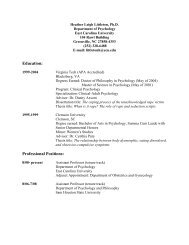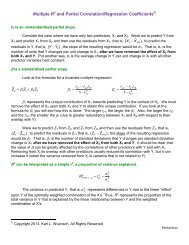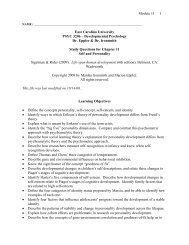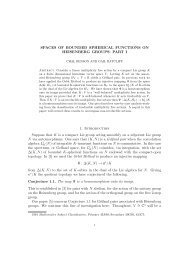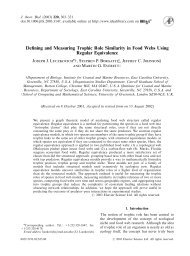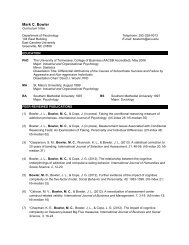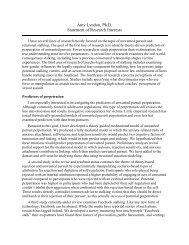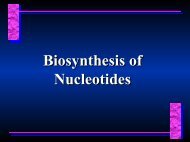Gelfand pairs associated with finite Heisenberg groups - Ecu - East ...
Gelfand pairs associated with finite Heisenberg groups - Ecu - East ...
Gelfand pairs associated with finite Heisenberg groups - Ecu - East ...
Create successful ePaper yourself
Turn your PDF publications into a flip-book with our unique Google optimized e-Paper software.
4 Chal Benson and Gail Ratcliff1.3 Oscillator representationThe symplectic group for ( W = F n × F n , [·, ·] ) ,Sp(n, F) = {g ∈ GL(2n, F) : [gz, gz ′ ] = [z, z ′ ]},acts by automorphisms on H n (F) viaFix λ ∈ F × . For given g ∈ Sp(n, F),g · (z, t) = (gz, t).(z, t) ↦→ π λ ◦ g(z, t) = π λ (gz, t)is an irreducible representation <strong>with</strong> central character ψ λ . The Stone-von NeumannTheorem ensures that π λ ◦ g is unitarily equivalent to π λ . Thus thereis a unitary operator ω λ (g) on C[F n ] satisfyingπ λ (gz, t) = ω λ (g)π λ (z, t)ω λ (g) −1 . (10)Schur’s Lemma shows that (10) defines ω λ (g) up to a multiplicative scalarof modulus one. In the context of <strong>finite</strong> fields, there is a systematic choice ofscalars for whichω λ : Sp(n, F) → U(C[F n ])is a representation of the group Sp(n, F). In the literature, ω λ is variouslycalled the oscillator, metaplectic, or Weil-Segal-Shale representation. It isknown that Sp(n, F) coincides <strong>with</strong> its commutator subgroup provided n > 1or q > 3. Thus (10) completely determines the representation ω λ , except whenn = 1 and q = 3. (See [How].)The contragredient representation πλ ∗ for π λ has central character ψ −λ .Thus πλ ∗ is unitarily equivalent to π −λ, by the Stone-von Neumann Theorem.Moreover the contragredient ωλ ∗ of the oscillator representation satisfiesπλ ∗(gz, t) = ω∗ λ (g)π∗ λ (z, t)ω∗ λ (g)−1 . It follows thatω ∗ λ is unitarily equivalent to ω −λ . (11)There are, in fact, just two distinct oscillator representations ω λ , up tounitary equivalence. IndeedProposition 1.2 (See [How], [Neu02]) For λ, λ ′ ∈ F × one has ω ′ λ ≃ ω λif and only if λ ′ /λ is a square in F × .The oscillator representation can be rendered explicitly, at least on a set ofgenerators for Sp(n, F). The formulas are given below in Theorem 1.3. Writing(2n) × (2n)-matrices in block form,[ ] A Bg =(A, B, C, D of size n × n),C D
6 Chal Benson and Gail Ratcliff2.1 Twisted convolution on C[W]Twisted convolution is well-known in connection <strong>with</strong> analysis on the real<strong>Heisenberg</strong> group H n (R). (See [Fol89].) Here we require its discrete analog.Definition 2.1 For f ∈ C[H] and a ∈ F define f a ∈ C[W] viaf a (z) =√ 1 ∑f(z, t)ψ a (t).qt∈FFor fixed z ∈ W, f a (z) is the (one-dimensional) inverse discrete Fourier transformof t ↦→ f(z, t) evaluated at a. The Fourier inversion formula yieldsf(z, t) =√ 1 ∑f a (z)ψ a (−t). (13)qa∈FIn particular, a function f ∈ C[H] is completely determined by {f aSo for given f, f ′ ∈ C[H],: a ∈ F}.f = f ′ ⇐⇒ f a = f ′ a for all a ∈ F. (14)Definition 2.2 For functions f, g ∈ C[W] and given a ∈ F we define thetwisted convolution f♮ a g ∈ C[W] via(f♮ a g)(z) = ∑ ( ) 1f(z − w)g(w)ψ a2 [z, w] .w∈WA straightforward calculation using (13) and (6) yields the following.Lemma 2.3 For f, g ∈ C[H] and a ∈ F one has(f ⋆ g) a = √ qf a ♮ a g a .2.2 K-invariant functions on H and WThe symplectic group Sp(n, F) acts on C[W] and C[H] viak · f(z) = f(k −1 z) and k · f(z, t) = f(k −1 · (z, t)) = f(k −1 z, t).For sub<strong>groups</strong> K of Sp(n, F) we let C[W] K and C[H] K denote the sets ofK-fixed elements in C[W] and C[H] respectively. These are easily seen to besubalgebras of C[W] and C[H] <strong>with</strong> respect to the convolutions ♮ a and ⋆.Definition 2.4 Given a subgroup K of Sp(n, F), we say that (K, H) is a<strong>Gelfand</strong> pair when C[H] K is a commutative algebra under convolution.Remark 2.5 One can identify C[H] K <strong>with</strong> the algebra C[K\G/K] of K-biinvariantfunctions on the semidirect product G = K ⋉ H. So (G, K) is a<strong>Gelfand</strong> pair in the traditional sense when Definition 2.4 applies.
<strong>Gelfand</strong> <strong>pairs</strong> <strong>associated</strong> <strong>with</strong> <strong>finite</strong> <strong>Heisenberg</strong> <strong>groups</strong> 7Proposition 2.6 Let K be a subgroup of Sp(n, F). Then (K, H) is a <strong>Gelfand</strong>pair if and only if hh ′ ∈ (Kh ′ )(Kh) for all h, h ′ ∈ H.Proof. This result is the discrete analog of Theorem 1.12 in [BJR90].⊓⊔Proposition 2.7 Let K be a subgroup of Sp(n, F). Then (K, H) is a <strong>Gelfand</strong>pair if and only if (C[W] K , ♮ λ ) is commutative for all λ ∈ F × .Proof. First note that (C[W] K , ♮ 0 ) is, in any case, commutative since ♮ 0 is thestandard (untwisted) convolution on C[W]. To complete the proof use (14)together <strong>with</strong> Lemma 2.3 and the the obvious identity(k · f) a = k · f a ,(k ∈ Sp(n, F), f ∈ C[H], a ∈ F). ⊓⊔Two immediate but useful properties of <strong>Gelfand</strong> <strong>pairs</strong> are noted in thefollowing lemma.Lemma 2.8 Let K 1 and K 2 be a pair of sub<strong>groups</strong> of Sp(n, F) and supposethat (K 1 , H) a <strong>Gelfand</strong> pair.(a) If K 1 ⊂ K 2 then (K 2 , H) is a <strong>Gelfand</strong> pair.(b) If K 1 , K 2 are conjugate in Sp(n, F) then (K 2 , H) is a <strong>Gelfand</strong> pair.3 <strong>Gelfand</strong> <strong>pairs</strong> and the oscillator representation3.1 Operator valued Fourier transform on C[W]For f ∈ C[W] and λ ∈ F × let π λ (f) denote the operatorπ λ (f) = ∑ f(z)π λ (z) (15)z∈Won C[W]. Here π λ (z) = π λ (z, 0) and π λ is the Schrödinger representation (8).The following standard result is easily verified.Lemma 3.1 π λ (f♮ λ g) = π λ (f)π λ (g) for f, g ∈ C[W] and λ ∈ F × .Lemma 3.2 The map π λ : C[W] → End(C[F n ]) is a vector space isomorphismfor each λ ∈ F × . In fact q −3n/2 π λ is a unitary isomorphism of C[W]onto End(C[F n ]) equipped <strong>with</strong> the Hilbert-Schmidt inner product〈T, S〉 HS = tr(T S ∗ ).
8 Chal Benson and Gail RatcliffProof. The set {q n/2 δ u: u ∈ F n } is an orthonormal basis for C[F n ] <strong>with</strong>So for f, f ′ ∈ C[W] we compute〈π λ (f), π λ (f ′ )〉 HS = ∑A calculation using (8) shows∑Thusπ λ (x, y)δ u = ψ λ (u · y − 2 −1 x · y)δ u−x .q n 〈π λ (f)δ u , π λ (f ′ )δ u 〉 F nu∈F n ∑=f(z), f ′ (z ′ )q n 〈π λ (z)δ u , π λ (z ′ )δ u 〉 F n.u∈F n ;z,z ′ ∈Wu∈F n 〈π λ (z)δ u , π λ (z ′ )δ u 〉 F n = δ z,z ′.〈π λ (f), π λ (f ′ )〉 HS = q n ∑ z∈Wf(z)f ′ (z) = q 3n 〈f, f ′ 〉 W .This shows q −3n/2 π λ : C[W] → End(C[F n ]) is unitary, hence injective. As thespaces C[W] and End(C[F n ]) have equal dimension it follows that π λ is anisomorphism of C[W] onto End(C[F n ]).⊓⊔3.2 Oscillator representationRecall that ω λ : Sp(n, F) → U(C[F n ]) denotes the oscillator representation,characterized by Equation 10. Now for k ∈ Sp(n, F) let ˜ω λ (k) be the operatoron End(C[F n ]) defined as˜ω λ (k)T = ω λ (k)T ω λ (k) −1 (16)One checks that ˜ω λ defines a unitary representation of Sp(n, F) on the Hermitianvector space (End(C[F n ], 〈·, ·〉 HS ). Moreover for k ∈ Sp(n, F) andf ∈ C[W] one hasπ λ (k · f) = ∑ z∈Wf(k −1 z)π λ (z) = ∑ w∈Wf(w)π λ (kw) = ˜ω λ (k)π λ (f), (17)since π λ (kw) = ω λ (k)π λ (w)ω λ (k) −1 . So the isomorphism π λ : C[W] →End(C[F n ]) intertwines the natural representation of Sp(n, F) on C[W] <strong>with</strong>˜ω λ .Definition 3.3 Let K be a subgroup of Sp(n, F). For λ ∈ F × we define thecommutant C λ,K of ˜ω λ (K) in End(C[F n ]) asC λ,K = End(C[F n ])˜ω λ(K) = {T ∈ End(C[F n ]) : ω λ (k)T = T ω λ (k) ∀k ∈ K}.Note that C λ,K is a subalgebra of End(C[F n ]).
<strong>Gelfand</strong> <strong>pairs</strong> <strong>associated</strong> <strong>with</strong> <strong>finite</strong> <strong>Heisenberg</strong> <strong>groups</strong> 9Proposition 3.4 π λC λ,K .yields an algebra isomorphism of (C[W] K , ♮ λ ) ontoProof. Taken together, Lemmas 3.1 and 3.2 show that π λ : C[W] → End(C[F n ])is an algebra isomorphism of (C[W], ♮ λ ) onto End(C[F n ]). Equation 17 showsthat π λ maps C[W] K onto C λ,K .⊓⊔Proposition 3.5 Let K be a subgroup of Sp(n, F) and λ ∈ F × . Then ω λ | Kis multiplicity free if and only if C λ,K is commutative.Proof. Suppose that ω λ | K is multiplicity free. So C[F n ] has a canonical decompositioninto pair-wise inequivalent ω λ (K)-irreducible subspaces:C[F n ] = P 1 ⊕ · · · ⊕ P msay. Schur’s Lemma shows that each operator T ∈ C λ,K must preserve theP j ’s and act by a scalar on each. Any two such operators commute <strong>with</strong> oneanother.Next suppose that ω λ | K is not multiplicity free. Hence C[F n ] has a decompositionof the sortC[F n ] = W 1 ⊕ W 2 ⊕ V,where W 1 , W 2 , V are ω λ (K)-invariant and W 1 , W 2 are ω λ (K)-irreducibleand equivalent. Thus C λ,K contains a copy of GL(2, F), and it fails to becommutative.⊓⊔Definition 3.6 We say that a subgroup K of Sp(n, F) is ω-multiplicity freeif the restriction ω λ | K of the oscillator representation to K is multiplicity freefor all λ ∈ F × .Together Propositions 2.7, 3.4 and 3.5 imply the following.Theorem 3.7 Let K be a subgroup of Sp(n, F). Then (K, H) is a <strong>Gelfand</strong>pair if and only if K is ω-multiplicity free.When applying Definition 3.6 it suffices to check that ω λ | K is multiplicityfree for at most two values of λ.Proposition 3.8 A subgroup K of Sp(n, F) is ω-multiplicity free if and onlyif ω 1 | K and ω ε | K are multiplicity free for any fixed choice of ε ∈ F × which isnot a square. Moreover when q ≡ 3 mod 4 it suffices that ω 1 | K be multiplicityfree.Proof. Proposition 1.2 implies that each oscillator representation ω λ is unitarilyequivalent to one of ω 1 or ω ε . If -1 is not a square in F, equivalentlywhen q ≡ 3 mod 4, we can take ε = −1. But ω −1 is contragredient to ω 1 by(11). So when ω 1 | K is multiplicity free so is ω −1 | K . ⊓⊔Remark 3.9 We do not know of an example where ω 1 | K is multiplicity freebut K fails to be ω-multiplicity free.
10 Chal Benson and Gail Ratcliff4 Counting and convolving K-orbits in WLet ρ denote the natural (unitary) representation of Sp(n, F) on C[W]:ρ(k)f(z) = k · f(z) = f(k −1 z),and ˜ω λ : Sp(n, F) → U(End(C[F n ]) be as in (16). We have seen that ρ and˜ω λ are unitarily equivalent via q −3n/2 π λ , a multiple of the operator valuedFourier transform. There is another viewpoint on this equivalence. Considerthe standard isomorphismΦ : C[F n ] ⊗ C[F n ] ∗ → End(C[F n ]),Φ(f ⊗ ϕ)(g) = ϕ(g)f.One checks easily that• Φ is unitary. (As before End(C[F n ]) carries the Hilbert-Schmidt innerproduct and we give C[F n ] ⊗ C[F n ] ∗ the tensor product of 〈·, ·〉 F n <strong>with</strong> itsdual inner product.)• Φ ( ω λ (k)f ⊗ ωλ ∗(k)ϕ) = ˜ω λ (k)Φ(f ⊗ ϕ).So Φ establishes a unitary equivalenceand the composite q 3n/2 π −1λω λ ⊗ ω ∗ λ ≃ ˜ω λ ,◦ Φ yieldsThis basic fact plays a central role in [How].ω λ ⊗ ω ∗ λ ≃ ρ. (18)4.1 Counting orbitsNow let K be a subgroup of Sp(n, F) and for λ ∈ F × decompose ω λ | K :ω λ | K ≃ ∑ σ∈ ̂Km σ,λ σ, m σ,λ = mult(σ, ω λ | K ).Writing d σ = dim(σ) one has∑m σ,λ d σ = dim(C[F n ]) = q n . (19)Also, applying (18):σ∈ ̂Kρ| K ≃ (ω λ ⊗ ω ∗ λ)| K ≃ ∑σ,σ ′ ∈ ̂Km σ,λ m σ ′ ,λσ ⊗ (σ ′ ) ∗ .We know that σ ⊗ (σ) ∗ has a one-dimensional space of K-fixed vectors andthat (σ ⊗ (σ ′ ) ∗ ) K = 0 when σ ′ ≄ σ. So
12 Chal Benson and Gail Ratcliff4.2 Convolving orbitsThe characteristic functions{δ Kz : Kz ∈ W/K}for the K-orbits in W yield an (orthogonal) basis for C[W] K . We computeδ Kz ♮ λ δ Kz ′(w) = ∑ v∈W=δ Kz (w − v)δ Kz ′(v)ψ λ (2 −1 [w, v])∑v∈(w−Kz)∩Kz ′ ψ λ (2 −1 [w, v]). (21)In view of Proposition 2.7, (K, H) will be a <strong>Gelfand</strong> pair if and only ifδ Kz ♮ λ δ Kz ′(w) = δ Kz ′♮ λ δ Kz (w) for all z, z ′ , w ∈ W and all λ ∈ F × . It is enoughto consider z ≠ 0 ≠ z ′ since δ K0 = δ 0 is a two-sided identity in (C[W], ♮ λ ).Moreover we can take w ≠ 0 because, in any case, f♮ λ g(0) = f♮ λ g(0) forfunctions f, g ∈ C[W]. This discussion yields the following.Lemma 4.3 (K, H) is a <strong>Gelfand</strong> pair if and only if∑∑ψ λ ([w, v]) =v∈(w−Kz)∩Kz ′for all z, z ′ , w ∈ W\{0} and λ ∈ F × .v∈(w−Kz ′ )∩Kzψ λ ([w, v])Remark 4.4 By Proposition 3.8 it suffices to check the condition in Lemma4.3 for at most two values of the parameter λ.Lemma 4.5 Suppose that there are K-invariant subspaces X and Y in W<strong>with</strong>X ∩ Y = 0, [X , Y] ≠ 0.Then (K, H) is not a <strong>Gelfand</strong> pair.Proof. Choose points z ∈ X and z ′ ∈ Y <strong>with</strong> [z, z ′ ] = 1 and let w = z + z ′ .We have(w − Kz) ∩ Kz ′ = {z ′ } .Indeed, suppose that v ∈ (w − Kz) ∩ Kz ′ . Thus for some k, k ′ ∈ K,w − kz = v = k ′ z ′ and hence z − kz = k ′ z ′ − z ′ .But z − kz ∈ X and k ′ z ′ − z ′ ∈ Y. So v = k ′ z ′ = z ′ since X ∩ Y = 0.Thus for these choices of z, z ′ and w we have∑v∈(w−Kz)∩Kz ′ ψ 1 ([w, v]) = ψ 1 ([z + z ′ , z ′ ]) = ψ 1 (1) = e 2πi/p .
Likewise∑v∈(w−Kz ′ )∩Kz<strong>Gelfand</strong> <strong>pairs</strong> <strong>associated</strong> <strong>with</strong> <strong>finite</strong> <strong>Heisenberg</strong> <strong>groups</strong> 13ψ 1 ([w, v]) = ψ 1 ([z + z ′ , z]) = ψ 1 (−1) = e −2πi/p .As p is odd, these values are necessarily different. So (K, H) fails to be a<strong>Gelfand</strong> pair in view of Lemma 4.3.⊓⊔Corollary 4.6 Let (K, H W ) be a <strong>Gelfand</strong> pair where K acts reductively butnon-irreducibly on W. So W decomposes as a direct sum of K-invariant subspaces,W = W 1 ⊕ · · · ⊕ W lsay. Let K j ⊂ GL(W j ) denote the restriction of K to W j . Then:(a) [W i , W j ] = 0 for all i ≠ j.(b) Each W j is a symplectic subspace of W and K j ⊂ Sp(W j ).(c) Each (K j , H Wj ) is a <strong>Gelfand</strong> pair.Corollary 4.7 Suppose we are given symplectic vector spaces (W j , [·, ·] j ) andsub<strong>groups</strong> K j ⊂ Sp(W j ) for j = 1, . . . l. We form the symplectic direct sumW = W 1 ⊕ · · · ⊕ W l , [(w 1 , . . . , w l ), (w ′ 1, . . . , w ′ l)] =and let K ⊂ Sp(W) denote the productK = K 1 × · · · × K l .l∑[w j , w j] ′ jThen (K, H W ) is a <strong>Gelfand</strong> pair if and only if (K j , H Wj ) is a <strong>Gelfand</strong> pairfor j = 1, . . . , l.Recall that a subspace X of the symplectic vector space W is said to beisotropic if [X , X ] = 0.Corollary 4.8 Suppose that K acts reductively on W and that the actionpreserves a non-zero isotropic subspace X . Then (K, H) is not a <strong>Gelfand</strong>pair.Proof. As K acts reductively on W we have W = X ⊕Y for some K-invariantsubspace Y. As X is isotropic we necessarily have [X , Y] ≠ 0.⊓⊔j=15 Examples5.1 Symplectic <strong>groups</strong>A trivial application of Lemma 4.3 shows that (Sp(n, F), H n (F)) is a <strong>Gelfand</strong>pair. Indeed, for K = Sp(n, F) we have only one non-zero K-orbit. That is
14 Chal Benson and Gail RatcliffKz = W\{0} for all z ≠ 0 in W. Equation 20 now shows that the oscillatorrepresentation ω λ must decompose into exactly two inequivalent irreducibleconstituents. This fact is well known. (See [How], [Neu02].) The ω λ (Sp(n, F))-irreducible subspaces of C[F n ] can be identified as follows.The matrix −I belongs to the center of Sp(n, F) and the first formula fromTheorem 1.3 shows that ω λ (−I) = sgn((−1) n )T whereT f(u) = f(−u).So the eigenspaces for T must be ω λ (Sp(n, F))-invariant. These are the spacesof even and odd functions. As ω λ has exactly two irreducible componentsthese spaces are necessarily irreducible.To obtain more interesting examples we must consider smaller sub<strong>groups</strong>of Sp(n, F).5.2 General linear <strong>groups</strong>The group GL(n, F) embeds diagonally in Sp(n, F) via {A diag : A ∈GL(n, F)}. (See (12).) The action of GL(n, F) on W = F n × F n preservesthe isotropic subspacesX = F n × {0}, Y = {0} × F n .So (GL(n, F), H n (F)) is not a <strong>Gelfand</strong> pair, in view of Corollary 4.8. Moregenerally, if K ⊂ Sp(n, F) is conjugate in Sp(n, F) to a subgroup of GL(n, F)then (K, H) is not a <strong>Gelfand</strong> pair.For n ≥ 2 there are q + 3 distinct GL(n, F)-orbits in W, namely{(0, 0)}, (F n \{0}) × {0}, {0} × (F n \{0}),{(x, y) : x ≠ 0 ≠ y, x · y = 0} and {(x, y) : x · y = a}for each a ∈ F × . So here |W/GL(n, F)| < q n , but (GL(n, F), H n (F)) is not a<strong>Gelfand</strong> pair. This shows that, for K non-abelian, there can be no conversefor Proposition 4.1.5.3 Borel sub<strong>groups</strong>A subgroup of Sp(n, F) conjugate to{[ ]}A 0B =C (A t ) −1 : A ∈ GL(n, F) lower triangular, A t C symmetricis called a Borel subgroup.Proposition 5.1 If K is a subgroup of Sp(n, F) that contains a Borel subgroupthen (K, H) is a <strong>Gelfand</strong> pair.
<strong>Gelfand</strong> <strong>pairs</strong> <strong>associated</strong> <strong>with</strong> <strong>finite</strong> <strong>Heisenberg</strong> <strong>groups</strong> 15Proof. It suffices to show that (B, H) is a <strong>Gelfand</strong> pair. This can be done usingProposition 2.6. There are exactly 2n non-zero B-orbits in W = F n × F n :n⊎W\{0} = Bu jj=1⊎n⊎Bv j where u j = (e j , 0), v j = (0, e j )j=1and {e j } is the standard basis for F n .Suppose that z ∈ Bu i and w ∈ Bu j . One has z ± w ∈ Bu min(i,j) , andhence z + w = k(z − w) for some k ∈ B. Let k ′ = −k and note that k ′ ∈ B,since −I ∈ B. Now(z, s)(w, t) = (z + w, s + t + 2 −1 [z, w])= (kz − kw, s + t + 2 −1 [kz, kw])= (k ′ w + kz, t + s + 2 −1 [k ′ w, kz])= (k ′ w, t)(kz, s).So (z, s)(w, t) ∈ (B(w, t))(B(z, s)). Similar calculations apply for other combinationsof orbits.⊓⊔One can also give an explicit description of the algebra (C[W] B , ♮ λ ) bydetermining the twisted convolution of <strong>pairs</strong> of characteristic functions forB-orbits in W. We adopt the notationE λ (z) = ∑ψ λ (2 −1 [z, w]) (z ∈ W, λ ∈ F × ).w∈BzBrute force calculation yields the following.{Eλ (uδ Bui ♮ λ δ Buj = max(i,j) )δ Bumin(i,j) for i ≠ jE λ (u i ) ∑ l≥i δ Bu l− δ Bui for i = j{Eλ (vδ Bvi ♮ λ δ Bvj = min(i,j) )δ Bvmax(i,j) for i ≠ jE λ (v i ) ∑ l≤i δ Bv l− δ Bvi for i = jδ Buj ♮ λ δ Bvi = δ Bvi ♮ λ δ Buj = E λ (v i )δ BujThese formulas show, in particular, that (C[W] B , ♮ λ ) is commutative, as guaranteedby Proposition 5.1.5.4 Unitary <strong>groups</strong>Let ˜F denote a quadratic extension of the field F = F q . Up to isomorphism ˜Fis a copy of F q 2. More concretely we choose any non-squarein F and takeε ∈ F × \(F × ) 2
16 Chal Benson and Gail Ratcliff˜F = F( √ ε).The Galois involution ˜F → ˜F will be written as z ↦→ z. One has z = z q anda + b √ ε = a − b √ ε(a, b ∈ F).Let (˜W, 〈·, ·〉) be a (<strong>finite</strong> dimensional) Hermitian vector space over ˜F.That is 〈·, ·〉 : ˜W × ˜W → ˜F is• F-bilinear and non-degenerate <strong>with</strong>• 〈λz, z ′ 〉 = λ〈z, z ′ 〉 and 〈z, z ′ 〉 = 〈z ′ , z〉 (z, z ′ ∈ ˜W, λ ∈ ˜F).The unitary group U(˜W) is the set of ˜F-linear operators preserving 〈·, ·〉.Let W denote the underlying F-vector space for ˜W. One obtains a symplecticform on W via[z, z ′ ] = 1 ()2 √ 〈z, zε′ 〉 − 〈z, z ′ 〉 = 1 ()2 √ 〈z ′ , z〉 − 〈z, z ′ 〉 .ε(Writing 〈z, z ′ 〉 ∈ F( √ ε) as 〈z, z ′ 〉 = 〈z, z ′ 〉 r + 〈z, z ′ 〉 i√ ε, one has [z, z ′ ] =−〈z, z ′ 〉 i .) Clearly U(˜W) is a subgroup of Sp(W), the symplectic group for(W, [·, ·]). We will prove that:Proposition 5.2 (U(˜W), H W ) is a <strong>Gelfand</strong> pair.It is well known that a given <strong>finite</strong> dimensional ˜F-vector space admitsexactly one hermitian inner product, up to equivalence. 1 In fact one can findan orthonormal basisB = {e 1 , . . . , e n }for (˜W, 〈·, ·〉) <strong>with</strong> 〈e i , e j 〉 = δ i,j . Using B to identify ˜W <strong>with</strong> ˜F n we have theusual formula〈z, z ′ 〉 = z 1 z ′ 1 + · · · + z nz ′ n.LetNow˜W j = ˜Fe j , W j denote ˜W j viewed as an F-vector space, f j = √ εe j .• {e j , f j } is a basis for W j ,• {e 1 , . . . , e n , f 1 , . . . , f n } is a symplectic basis for W (i.e. [e i , e j ] = 0 =[f i , f j ], [e i , f j ] = δ i,j ), and• W = W 1 ⊕ · · · ⊕ W n is a symplectic direct sum.1 In contrast, the complex vector space C n admits ⌊(n + 2)/2⌋ inequivalent Hermitianinner products. These yield distinct unitary <strong>groups</strong> U(r, s) <strong>with</strong> r + s = n.The analogs for these Hermitian inner products in the <strong>finite</strong> fields context are,however, mutually equivalent.
<strong>Gelfand</strong> <strong>pairs</strong> <strong>associated</strong> <strong>with</strong> <strong>finite</strong> <strong>Heisenberg</strong> <strong>groups</strong> 17The restriction of 〈·, ·〉 to ˜W j is a hermitian inner product on ˜W j . We considerthe sub<strong>groups</strong> U(˜W i ) ⊂ Sp(W j ) and their direct productU(˜W 1 ) × · · · × U(˜W n ) ⊂ U(˜W) ⊂ Sp(W),the subgroup of U(˜W) preserving the decomposition W = W 1 ⊕ · · · ⊕ W n .The following result evidentally implies Proposition 5.2.Proposition 5.3 ( U(˜W 1 ) × · · · × U(˜W n ), H W)is a <strong>Gelfand</strong> pair.Proof. In view of Corollary 4.7 it suffices to show that each ( U(˜W j ), H Wj)is a <strong>Gelfand</strong> pair. This amounts to showing that (U(˜F), H 1 (F)) is a <strong>Gelfand</strong>pair, where ˜F carries the Hermitian inner productNowis the kernel of the norm mapping〈z, z ′ 〉 = zz ′ .U(˜F) = {λ ∈ ˜F × : λλ = 1},N : ˜F → F,N(λ) = λλrestricted to the multiplicative group ˜F × for the field ˜F. So U(˜F) is, in particular,abelian. Moreover a pair of points z, z ′ ∈ ˜F belong to a common U(˜F)-orbitin ˜F if and only if N(z) = N(z ′ ). So|˜F/U(˜F)| = |N(˜F)| = |F| = q,as it is well known that N is surjective. Proposition 4.2 now implies that(U(˜F), H 1 (F)) is a <strong>Gelfand</strong> pair as desired.⊓⊔Remark 5.4 As U(˜F) is the kernel of the epimorphism N : ˜F × → F × , it iscyclic of order q + 1.Our final result asserts that the <strong>Gelfand</strong> pair in Proposition 5.3 is minimal.The analogous theorem for real <strong>Heisenberg</strong> <strong>groups</strong> H n (R) is due to Leptin[Lep85].Proposition 5.5 (K, H W ) fails to be a <strong>Gelfand</strong> pair for all proper sub<strong>groups</strong>K of the torus U(˜W 1 ) × · · · × U(˜W n ).Proof. We can take ˜W jproduct. Now the torus= ˜F and ˜W = ˜F n <strong>with</strong> the usual hermitian innerT = U(˜F) × · · · × U(˜F)coincides <strong>with</strong> a T -orbit in ˜W. Namely one has
18 Chal Benson and Gail RatcliffT · z ◦ = T for z ◦ = (1, 1, . . . , 1).Let K denote a proper subgroup of T . The T -orbit T ·z ◦ is a disjoint unionof |T/K| orbits for the subgroup K. These correspond to the cosets of K inT . As (T, H W ) is a <strong>Gelfand</strong> pair we have |W/T | = q n and|W/K| ≥ q n − 1 + |T/K| > q n .So (K, H W ) fails to be a <strong>Gelfand</strong> pair by Proposition 4.2.⊓⊔References[BJR90] Chal Benson, Joe Jenkins, and Gail Ratcliff. On Gel ′ fand <strong>pairs</strong> <strong>associated</strong><strong>with</strong> solvable Lie <strong>groups</strong>. Trans. Amer. Math. Soc., 321(1):85–116, 1990.[Fol89] Gerald B. Folland. Harmonic analysis in phase space, volume 122 of Annalsof Mathematics Studies. Princeton University Press, Princeton, NJ, 1989.[Gér77] Paul Gérardin. Weil representations <strong>associated</strong> to <strong>finite</strong> fields. J. Algebra,46(1):54–101, 1977.[Hel84] Sigurdur Helgason. Groups and geometric analysis, volume 113 of Pure andApplied Mathematics. Academic Press Inc., Orlando, FL, 1984. Integralgeometry, invariant differential operators, and spherical functions.[How] Roger E. Howe. Invariant theory and duality for classical <strong>groups</strong> over <strong>finite</strong>fields, <strong>with</strong> applications to their singular representation theory. Unpublishedmanuscript.[How73] Roger E. Howe. On the character of Weil’s representation. Trans. Amer.Math. Soc., 177:287–298, 1973.[Lep85] Horst Leptin. A new kind of eigenfunction expansions on <strong>groups</strong>. PacificJ. Math., 116(1):45–67, 1985.[LN] Rudolf Lidl and Harald Niederreiter. Finite fields, volume 20 of Encyclopediaof Mathematics and its Applications. Second edition.[Mac] I. G. Macdonald. Symmetric functions and Hall polynomials. Oxford MathematicalMonographs. Second edition.[Neu02] Markus Neuhauser. An explicit construction of the metaplectic representationover a <strong>finite</strong> field. J. Lie Theory, 12(1):15–30, 2002.[SA87] Jorge Soto-Andrade. Geometrical Gel ′ fand models, tensor quotients, andWeil representations. In The Arcata Conference on Representations of FiniteGroups (Arcata, Calif., 1986), volume 47 of Proc. Sympos. Pure Math.,pages 305–316. Amer. Math. Soc., Providence, RI, 1987.[Shi80] Ken-ichi Shinoda. The characters of Weil representations <strong>associated</strong> to<strong>finite</strong> fields. J. Algebra, 66(1):251–280, 1980.[Ter99] Audrey Terras. Fourier analysis on <strong>finite</strong> <strong>groups</strong> and applications, volume43 of London Mathematical Society Student Texts. Cambridge UniversityPress, Cambridge, 1999.[Vin03] È. B. Vinberg. Commutative homogeneous spaces of <strong>Heisenberg</strong> type. Tr.Mosk. Mat. Obs., 64:54–89, 2003.[Yak06] Oksana Yakimova. Principal <strong>Gelfand</strong> <strong>pairs</strong>. Transform. Groups, 11(2):305–335, 2006.



